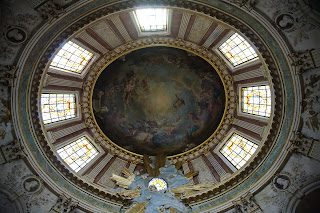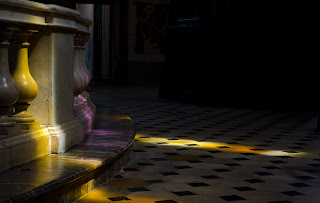In 1789, after the Revolution, the church was consecrated as the Temple du Génie (which explains why it is Genie's favourite church; I faithfully follow her daily blog, Paris and Beyond).
The south-facing facade is modeled on the style favoured by the Jesuits in the 17th century.
We enter from the back of the nave, which is built in a neoclassic style utilizing Roman arches and a series of domes, which are essentially interlocking (crisscrossing) barrel vaults. The upper windows offer excellent lighting on sunny days. Some central heating has been added by means of grates in the floor, but heating buildings this tall is unbelievably expensive.
A young family, with the cutest children imaginable, visited the clergy that afternoon, possibly for the baptism of their youngest child?
Many of the windows are essentially clear (which admits the most light possible) but others are glazed with stained and beautifully painted glass.
The two side aisles give access to a series of outer chapels, each dedicated to a different saint. The design of the pillars articulating the chapels beautifully continues the unified appearance of the primary pillars in the nave.
Most of the side chapels could not be entered by laity during my visit, but two heights of wooden wicker chairs were provided which enabled the faithful either to sit or kneel while facing the chapel.
Votive candles are available at various stations along these lengthy aisles. During the past several decades, it has become increasingly fashionable to use glass holders of a unified colour bearing the name of the church's patron saint. The more traditional white tapers are also available.
One niche commemorates those killed in concentration camps: "Buchenwald, 15,000 martyrs", "Auschwitz, 140,000 martyrs", "Dachau, 10,000 martyrs", Oranienburg, 10,000 martyrs . . . ." The names of the camps surround a cross bearing the three colours of the French flag. In fact, many who perished were taken from Paris, leaving the city by boat from behind Notre Dame.
Now we are standing in the aisle to the east (remember: N-S axis), looking across the new wooden stage for the new altar. Typically, pre-Vatican II churches retain the original high altar but then construct another altar on a new platform which much closer to where the people sit.
The high altar is also slightly raised, but on beautiful marble with a wrought iron communion rail. On the floor level at each corner of this communion rail are the intertwining letters "SR" for Saint Roch.
On the afternoon of my visit (June 5th), the music lectern supported two pages of printed chant sung by the celebrant when blessing the baptismal font after Pentecost (Roman Rite).
We could not enter the choir proper, but I was able to take this photo while standing behind the two rows of choir stalls for the Cantores. From that position, we look toward the back of Saint-Roch, toward the magnificent pipe organ (1842) positioned over the central door at the western facade.
Here we are standing in the nave, looking past the new altar (wood), past the darkened high altar (with the high cross and candlesticks), through to the burst of light above the nativity scene (in the Chapel of the Virgin), and finally through to a painting depicting of the crucifixion (blue background, in the last chapel, that for Calvary). This is an unusual sequence of open spaces. (Since I did not have my tripod, I could not photograph the Chapel of Calvary, which is purposefully darker and smaller, inviting one to meditate on the Crucifixion alone.)
Immediately behind the high altar is a large chapel, which essentially extends the choir to the north, even though it is distinct from it. Above the altar in this Chapel of the Virgin is a sculpted scene of Mary and Joseph adoring the infant Jesus. Two saints stand beside this scene, St Jerome (on the left) and St Barbe (on the right). The communion rail is made of a light-coloured stone. Above the nativity scene we see a sculpture depicting the Glory of God--a brilliant burst of rays of light piercing the dark gray cloud, with faces of putti (child angels) in evidence.
This gives a closer view of St Jerome, who was apparently in remarkably good physical shape.
While standing in this second area, the Chapel of the Virgin, we can look toward the back of the sanctuary, past the tall candlesticks and cross on the high altar, and see the dome over the transept and the pipe organ.
Since we had recently celebrated Pentecost, additional chairs had been placed in an otherwise nondescript passageway leading from the ambulatory to the chapel's altar. The church had apparently made provision for an overflow congregation for the high feast day. We get a dim view of the elliptical ceiling over the chapel. Its axis is E-W, in an attempt to honour the traditional orientation.
The oval ceiling is wonderful, sustaining a copula with seven brightly glazed windows offering excellent lighting during the day.
The lighting on this sculpture seemed to make the marble become life-like, the stone almost glowing with warmth.
Although marble is featured throughout Saint-Roch, some of the most eye-catching "marble" is actually wood painted to look like marble. This time-honoured craft is still being practiced today around the world.
Photographing stained glass windows presents more challenges than I can manage, but by underexposing, I managed to capture a bit of one window in its architectural context.
The severity of the clear glazing (which reveals that the city's air really is polluted) and the silhouetted cross is put in context by the bit of brightly-coloured glass on the edge. I obviously need to reshoot this.
Ceilings are always fascinating, whether they are made of carefully carved stone or are covered with white plaster. But the most intriguing ceilings are those carefully painted, and then properly illuminated by natural light. In the first photo (below), we are standing under the transept. The painted ceiling (1864) on the right is above the choir, that on the left is above the nave proper, and the two truncated ceilings are over the transept.
Light from the stained glass windows sometimes creates interesting patterns on otherwise colourless stone throughout the church.
As I prepared to leave Saint-Roch, the light streaming from under the back door let me know that the day was still bright and sunny.






































